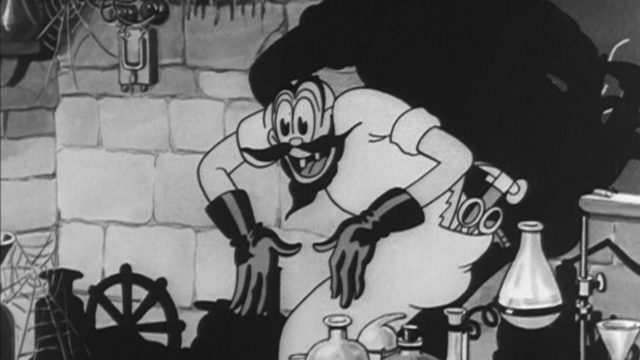Disney shorts were, for the most part, better crafted but safer and staider than the Fleischers’. You could call Disney the classical to the Flesischers’ jazz, and that’s certainly reflected in their respective soundtracks, but it also overstates the point. Better to say Flesicher was the neighborhood combo in a seedy bar Disney was big band swing for the black-tie set.
But, as anyone who’s been forever haunted by Dumbo’s pink elephants or Pinocchio’s donkey-based body horror, or even Disney’s own version of Snow White, can tell you, the studio was more than capable of the nightmare surrealism of the ’33 Snow White. And there are few better examples than The Mad Doctor, which, if not Snow White’s equal, is darned close.
The titular doctor is a brilliant creation, playing up the unsettling effect of the enormous eyes and ragdoll movements that were cartoon SOP at the time for all they’re worth. Most animated characters were virtually boneless until Disney started sending his animators to art school during this period, but the mad doctor takes the “rubber hose” style of animation to its limits. He doesn’t just bend like a hose, he undulates like a sea-dwelling invertebrate. He’s more likely to crouch so severely his head is level with waist than stand up straight. As for the facial design, it’s most unsettling in one scene where he begins cackling and advancing on the audience with a butcher knife until his face fills the screen.
No wonder this cartoon was such an inspiration to the Mickey Mouse comic strip, drawn at the time by the great Floyd Gottfredson, who ran with the “Doctor XXX” nameplate on the lab’s door and created three mad-scientist monkeys for his tie-in storyline: Doctors Ecks, Double Ecks, and Triple Ecks, who’ve remained a part of the comics cast to this day. Years later, Gottfredson would introduce an even more durable villain named the Phantom Blot, who looks suspiciously like the Mad Doctor in the all-covering, inky-black cloak he wears to abduct Pluto.
But the real star here is the Mad Doctor’s castle, realized in shadowy ink washes as effective as the greatest live-action horror films of the era. That’s true of the exterior — a Gothic castle on a wave-lashed, skull-shaped rock, like the one King Kong inhabited the same year or Disney would adapt from Peter Pan decades later — and the skeleton-packed interior.
Disney does cut a few corners — the scene of Mickey creeping through the castle hall and getting spooked by a ceiling slab falling behind him is copied, soundtrack and all, from their 1931 Silly Symphony Egyptian Melodies. But hey, with animation this impressive, you may as well get your money’s worth. The skeletons have a grand old time fucking up Mickey’s shit, most horrifyingly when one of them engulfs the mouse in its ribcage then falls limp and dead, leaving him trapped. Not to be outdone in the surreal horror department, the Doctor himself cuts Pluto’s shadow in half.
Walt Disney gets credit for a whole lot of things — some of which he even did! — but he rarely gets enough credit for his voice performance as Mickey. His tentative calling for Pluto gives the short a poignance on top of all the gags, and as absurd as the short gets, it really makes you believe in the love between this mouse and this dog. Shame they have to squander all that goodwill in the final stretch with a horseshit “It was all a dream” ending. It sort of fits for such an effectively nightmarish film. But it mostly feels like a cheat, like the writers figured out how to get Mickey strapped to an operating table with a buzz saw approaching his crotch (and I have to wonder if they were aware of the castration imagery) and then decided that was enough creativity for one day and copped out of getting him back out. At least Disney would learn to play fair later and come clean when a character’s dreaming from the beginning from the beginning with later shorts like Thru the Mirror or Pluto’s Judgment Day. |

